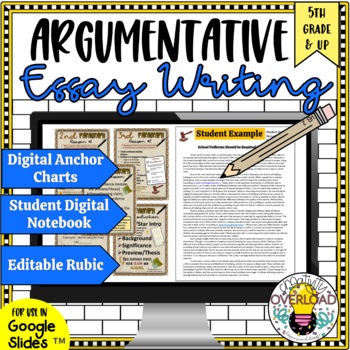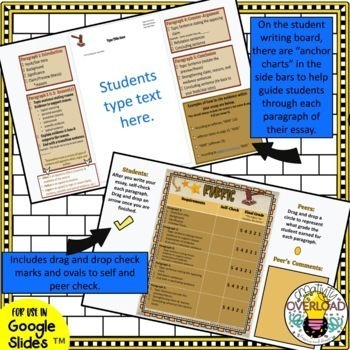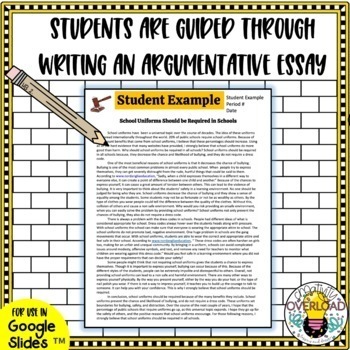How to Write an Argumentative Essay for Middle School Students|Google Slides
- Google Drive™ folder

What educators are saying
Description
Guide your middle school students through the art of writing an argument essay with this step-by-step Google Slides digital resource. It includes editable interactive notebooks (teacher and student), a graphic organizer, anchor charts, rubric, student exemplar, and a digital class book template. Students complete an argumentative graphic organizer focusing on claim, reasons, evidence, and counter-argument. Afterward, teachers use the digital anchor charts to guide students paragraph by paragraph through writing their argumentative essay. Students learn to "hook" the audience, write topic and transition sentences, refute the counter-argument, use MLA format correctly, embed ethos, pathos, and logos, etc. Student then reflect on their essay, using the movable checkmarks on the rubric. Students can also peer edit, moving the drag and drop ovals to the "grade" earned on the rubric. Finally, this resource includes a digital class book template, where all essays can be inserted into one Google Slides. These digital class books are perfect to place in virtual classroom libraries, share with parents, other classes, etc. Most slides are editable, so change as desired. All slides have been formatted to be 8.5'X11, so printing is an option. These make great displays.
Why use this resource? teaches critical thinking skills ✤ standards-based ✤ can be used over and over again✤ saves paper ✤ interactive & engaging ✤ can be used in class or during distance learning ✤editable
⭐️ Argumentative Essay Writing Includes: Format: Google Slides
✔. Teacher Guide (PDF)
✔ Teacher Digital Notebook *This is meant to be shared on your interactive whiteboard and used to guide students through the writing of their essay.
- Cover Slide
- CCSS Standard Slide (editable)
- Anchor Charts (paragraphs 1-5) *Includes examples of MLA format and ethos, pathos, and logos
- Student Exemplar (7th grade student example- editable)
- Graphic Organizer and Rubric (both editable)
✔ Student Digital Notebook *Assign in Google Classroom or share link
- Graphic Organizer
- Rubric with movable pieces for self and peer checking
- Essay Writing Template with "anchor charts" in the side-bars to guide students
- Student exemplar
✔. Teacher Rubric (same as students, but with comments from the teacher in the side-bars)
★You many also be interested in in my Weekly Writing Sets where one of the four types of writing is practiced every day for 10 minutes. Fantastic daily writing warm-ups!
You may also like some of my other speech and debate resources:
- Debate Choice Board: Digital Argumentative Topics & Graphic Organizers/Google
- Digital Debates: Interactive Google Class Debates/works with any topic/reusable
- Public Speaking Activity:"Inanimate Object" Speeches/Google & Print/CCSS aligned
- Philosophical Chairs: An engaging class or group debate over any topic, Google
I would ❤️ for you to ⇨ FOLLOW ME to see new products as soon as they come out. Any reviews would be greatly appreciated too. You earn TPT points for credit on future products you purchase. We can also connect on ❤️Instagram & ❤️Pinterest ☺





